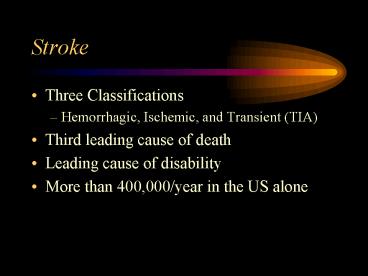Stroke PowerPoint PPT Presentation
1 / 24
Title: Stroke
1
Stroke
- Three Classifications
- Hemorrhagic, Ischemic, and Transient (TIA)
- Third leading cause of death
- Leading cause of disability
- More than 400,000/year in the US alone
2
Stroke
- Greg Cuculino
3
Presentation
- Weakness of one or more extremities
- Visual loss/visual field deficits/double vision
- Slurred speech
- Facial Droop
- Differentiate between central 7th nerve palsy
(CVA) and a peripheral 7th nerve palsy - If the patient can wrinkle the forehead it is a
central nerve palsy, if not it is peripheral
4
Presentation contd
- Dizziness
- Difficulty walking
- Difficulty communicating
- Expressive or receptive aphasia
- Decreased level of consciousness
5
Risk Factors
- Age
- The risk doubles every decade
- HTN
- Smoking
- CAD
- Increased cholesterol
- A fib
6
Hemorrhagic
- 10-15 of all strokes
- Higher mortality than ischemic strokes
- Tend to be more ill than ischemic strokes
- More likely to have headache, altered mental
status, seizures, nausea, vomiting, or elevated
blood pressure - But none of these are reliable indicators of a
bleed
7
Causes
- Bleeding from damaged vessels from chronic
hypertension, bleeding diasthesis, iatrogenic
anticoagulation, cocaine, AVM, aneurysm,
neoplasm, trauma - Higher incidence in African Americans
8
Misc
- ICH are usually found in the thalamus, putamen,
cerebellum, and brain stem - Not only does the hemorrhage cause damage, the
resulting hematoma causes mass effect and further
injury - Only 20 of patients regain functional
independence - High 30 day mortality rate (40-80)
- 50 occur in the first 48 hours
- Seizures more common than in ischemic strokes
9
Ischemic
- 85 of all strokes are ischemic
- Can be embolic,
- From the heart or carotids
- thrombotic,
- Carotids, intracerebral arteries,
vasoconstriction due to migraines - or due to flow disturbances
- Polycythemia, sickle cell disease, hypotension
- 25 occur in people UNDER 65!!!
10
TIA
- A stroke-like deficit that resolves in under 24
hrs - 80 resolve within 60 minutes
- Median duration is 14 minutes
- A warning sign for a future stroke
- Precede nearly 30 of all strokes
- One third of TIAs will have a stroke within one
month, 50 within one year
11
Work-Up (Pre-Hospital)
- Recognition, Recognition, Recognition
- Cincinnati Pre-Hopsital Stroke Scale
- Facial droop, arm drift, speech
- ABCs
- Accu check
- Rapid Transport
12
Work-Up (Initial)
- Labs
- CBC, BMP, PT/PTT
- Assessing electrolytes (esp. glucose) and
evidence of polycythemia or coagulopathy - ECG
- Evidence of dysrythmia (afib)
- CT without contrast
- CT more sensitive in ruling out bleeding than MRI
13
Treatment
- Hemorrhagic CVAs
- Immediate neurology and neurosurgery consult for
possible OR - Correction of coagulopathy
- Blood Pressure management
- Must maintain mean arterial pressure between 90
and 130 mm Hg - Can use multiple medications
14
Treatment cont..
- Admission to the ICU
- Expansion of the hematoma is the most common
cause of neurologic deterioration within the
first three hours - 25 of patients will have a decrease in LOC
within the first 5 hours - Post stroke seizures may occur
- Many patients will get prophylactic dilantin
15
TIAs
- Anti-platelet therapy
- Searching for any treatable cause
- Afib, carotid artery stenosis
16
Ischemic Stroke
- The goal is to restore blood flow if possible and
decrease the area injured - To lyse or not to lyse
- TPA has demonstrated a statistically significant
increase in full recovery of patients - However, increase in bleeding complications
- BP management
- Differs for TPA or no TPA
17
TPA
- Indications
- Ischemic CVA
- lt 3 hours from time of onset
18
TPA contd..
- Contraindications
- lt18 y/o
- Mild CVA symptoms (NIHSS lt4)
- Rapidly improving symptoms
- Hypertension(BP gt 185/110 after treatment)
- Bleed on CT
- Platelets lt100K
- INR gt1.7
19
Contraindications contd
- Stroke or significant trauma within 3 months
- History of ICH or SAH
- History of aneurysm, AVM, or brain tumor
- Hemorrhage within 21 days
- Major surgery within 14 days
- Other miscellaneous issues
20
TPA
- Dose
- 0.9 mg/kg
- 10 over first minute then remainder over one hour
21
BP management
- Lower systolic BP below 185 and diastolic below
110 using labetolol, nipride, nitroglycerin,
nicardipine, or others
22
Non-TPA Treatment
- BP management
- If lower too much or too quickly can WORSEN
symptoms - Only treat if MAPgt150 mm Hg
- Can use multiple drugs but NOT sublingual
procardia
23
Treatment contd
- Anti-Platelet therapy/anticoagulation
- Aspirin/plavix/ aggrenox/coumadin/heparin
- Must assess swallowing prior giving po meds
- Cranial nerve assessment, handling of secretions,
swallowing assessment - If they fail, ASA per rectum
24
(No Transcript)

